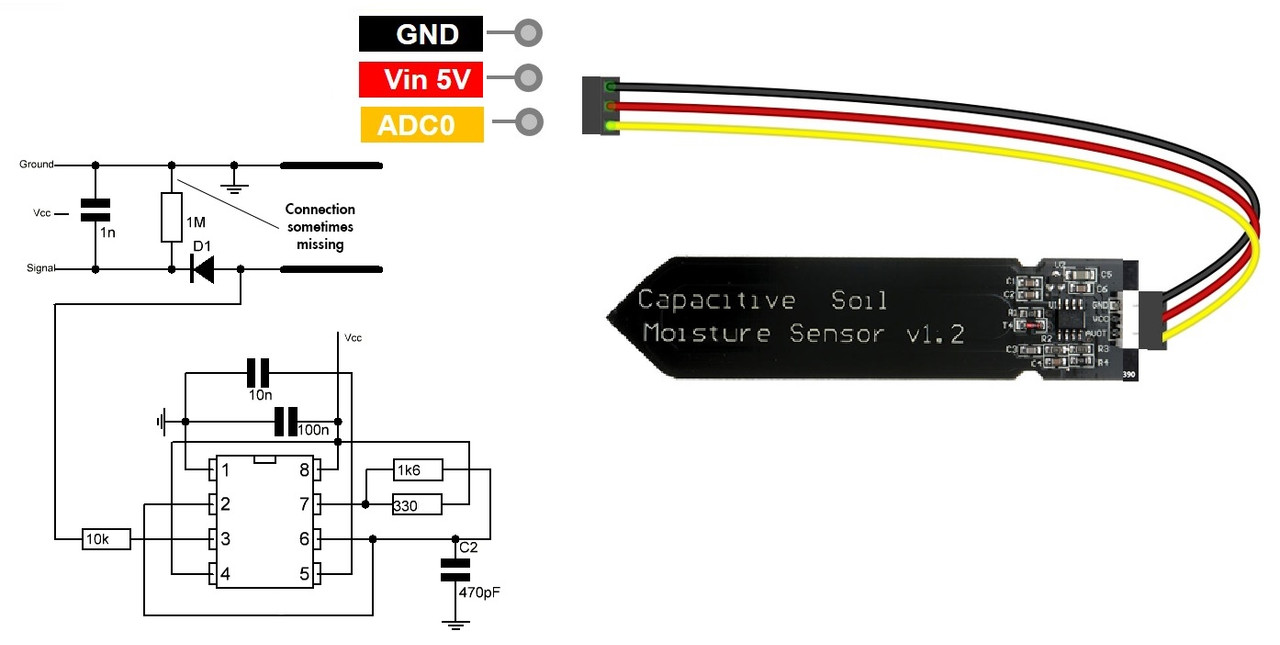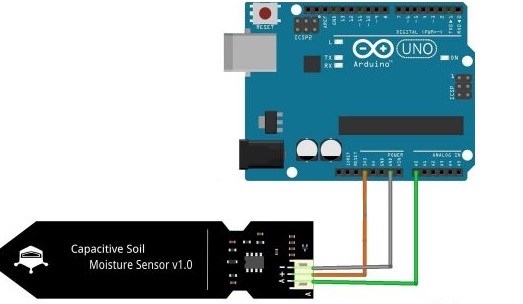Out Of Stock
Description
The Soil Moisture Sensor is used to measure the amount of moisture in the soil used to calculate the amount of water in it, it uses capacitive sensing to Sense soil moisture levels. The device also contains an onboard voltage regulator, allowing it to operate between 3.3 and 5.5V. It works with low-voltage MCUs and is compatible with a Raspberry Pi.
Package Includes:
- 1 x Capacitive Soil Moisture Sensor
- 1 x Connection Cable
Features:
-
This analog capacitive soil moisture sensor measures soil moisture levels by capacitive sensing,
-
rather than resistive sensing like other types of moisture sensor
-
It is made of a corrosion-resistant material giving it a long service life
-
Insert it into the soil and impress your friends with the real-time soil moisture data
-
This module includes an on-board voltage regulator which gives it an operating voltage range of 3.3 ~ 5.5V
Description:
The Soil Moisture Sensor is used to measure the amount of moisture in the soil. The moisture content of the soil may be used to calculate the amount of water in it. The sensor uses capacitive sensing rather than resistive sensing like other types of moisture sensors to Sense soil moisture levels. Because it is composed of a corrosion-resistant substance, it can prevent corrosion and has a long service life. The device also contains an onboard voltage regulator, allowing it to operate between 3.3 and 5.5V. It works with low-voltage MCUs (both 3.3V and 5V logic). An ADC converter is required to make it compatible with a Raspberry Pi.
Principle of Work:
A capacitor is made up of three parts. A positive plate, a negative plate, and the dielectric gap between the plates. Capacitors come in many physical shapes, but they all contain two metal plates with a dielectric between them. A capacitive moisture sensor operates by sensing capacitance changes produced by dielectric changes. It does not directly detect soil moisture (since pure water does not transmit electricity effectively), but rather the ions that are dissolved in the moisture. Capacitive measurement essentially measures the dielectric generated by the soil, with water being the most critical component influencing the dielectric. The sensor's capacitance is measured using a 555 timer-based circuit that generates a voltage that is directly proportionate to the capacitor implanted in the soil. We next utilize an Analog Digital Converter to measure this voltage, which provides a number that we represent as a percentage of soil moisture.
Pinout of the Module:

The capacitive soil moisture sensor has three pins:
-
GND pin: connect this pin to GND (0V)
-
VCC pin: connect this pin to VCC (5V or 3.3v)
-
AOUT pin: Analog signal output pin outputs the voltage in direct proportion to the soil moisture level.
Applications:
- Gardening monitoring system
- Watering system
Circuit:
The module's Ground and VCC pins must be connected to the Arduino Board's Ground, and the Out pins to pin A0 on the Arduino Board.

Library:
no library is needed.
Code:
const int AirValue = 600; //you need to replace this value with Value_1
const int WaterValue = 350; //you need to replace this value with Value_2
int soilMoistureValue = 0;
int soilmoisturepercent=0;
void setup() {
Serial.begin(9600); // open serial port, set the baud rate to 9600 bps
}
void loop() {
soilMoistureValue = analogRead(A0); //put Sensor insert into soil
Serial.println(soilMoistureValue);
soilmoisturepercent = map(soilMoistureValue, AirValue, WaterValue, 0, 100);
if(soilmoisturepercent >= 100)
{
Serial.println("100 %");
delay(250);
}
else if(soilmoisturepercent <=0)
{
Serial.println("0 %");
delay(250);
}
else if(soilmoisturepercent >0 && soilmoisturepercent < 100)
{
Serial.print(soilmoisturepercent);
Serial.println("%");
delay(250);
}
}
Once the sketch has been uploaded, open a Serial Monitor window to view the Arduino's output. you can see the soil moisture percentage on SerialMonitor.
Procedure for Calibration:

- Calculate the weight of the soil sample container.
- Fill the container to a capacity of 200ml (or any other amount) with dry soil.
- Calculate the mass of dry soil in the container.
- Wet the soil with 10ml of water (this is 5%, but any larger percentage is OK).
- Refill the container to 200ml after mixing the wet dirt about to ensure that the water is equally spread.
- Calculate the weight of the moist earth.
- Repeat stages 4–6 until the soil is saturated and begins to leak water.
- Once the watering method has attained saturation, spread the 200ml of soil out on a sheet of wax paper to dry.
-
When the soil is dry, weigh it; this is the dry soil mass that will be used to calculate soil density.
When the drying process is included in, the aforementioned technique might take up to 7 days. The experimental technique can take around 10 minutes for every measurement (packing, watering, settling), and with 6-10 measurements per experiment, the real labor can take about 1-2 hours. Thus, the full-scale experiment takes around 7 days after the initial few days of drying the soil, plus 2 hours of tests and a few days of drying the soil out. To ensure the quickest experimentation, spread the soil out very thinly on the wax paper. This will provide approximately 7 days per soil calibration.
Technical Details:
- Operating Voltage: 3.3 ~ 5.5 VDC.
- Operating Current: 5mA.
- Interface: PH2.54-3P.
- Dimensions mm(LxWxH): 98 x 23 x 4.
- Supports 3-Pin Sensor interface
- Analog output.
- Weight (gm): 15.
Resources:
Comparisons:
The sensor uses capacitive sensing rather than resistive sensing like other types of moisture sensors to assess soil moisture levels. Because it is composed of a corrosion-resistant substance, it can prevent corrosion and has a long service life.
The device also contains an onboard voltage regulator, allowing it to operate between 3.3 and 5.5V. It works with low-voltage MCUs (both 3.3V and 5V logic). An ADC converter is required to make it compatible with a Raspberry Pi all of this is available with the (Soil Moisture Sensor & Soil Hygrometer Detection Module) but on another board included with the main sensor. Capacitive measuring offers certain advantages over traditional resistive soil sensors in that it not only prevents probe corrosion but also provides a more accurate readout of soil moisture content than resistance measuring, it does not measure moisture (since water is a poor conductor of current), but rather the ions that are dissolved in the moisture, i.e. adding fertilizer will reduce soil resistance even if no water is provided. Capacitive measurement essentially measures the dielectric generated by the soil, with water being the most critical ingredient in forming that dielectric. but still, the (Soil Moisture Sensor & Soil Hygrometer Detection Module) gives the ability to get a digital and analog output and not only analog output like the capacitive module.